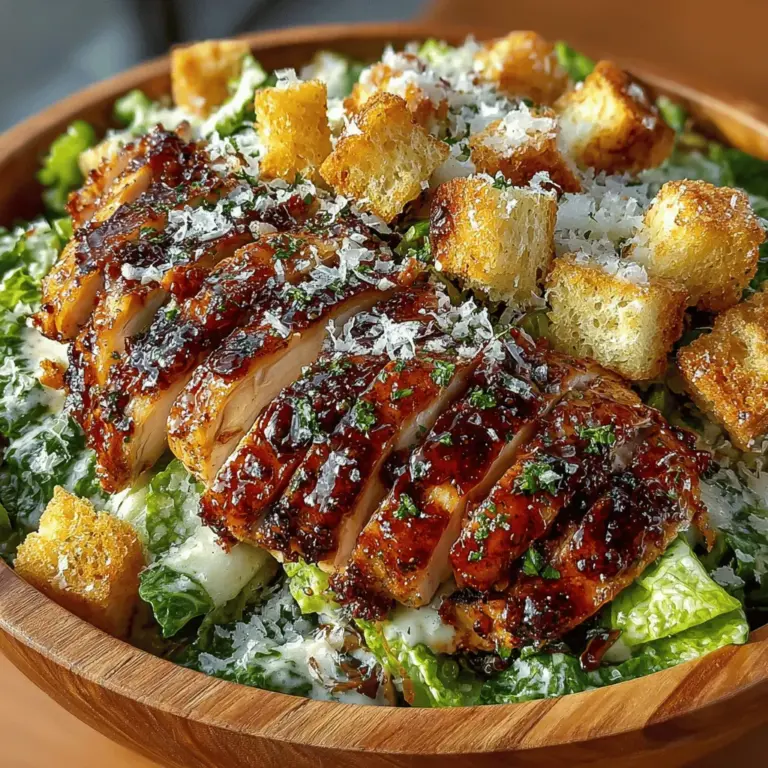Introduction to Classic Chicken Caesar Salad Delight
Exploring the world of salads unveils a treasure trove of flavors, textures, and culinary creativity. Among these, the Classic Chicken Caesar Salad stands out as a timeless favorite, combining tender grilled chicken, crisp romaine lettuce, crunchy croutons, and a rich, creamy dressing. This article will provide you with a comprehensive guide to preparing this delightful dish, ensuring that you can impress your family or guests with a restaurant-quality salad right at home.
The Allure of the Chicken Caesar Salad
The Chicken Caesar Salad is more than just a dish; it’s a celebration of fresh ingredients and bold flavors. Its roots can be traced back to the early 20th century in Tijuana, Mexico, where it was purportedly created by Italian immigrant Caesar Cardini. The original recipe was a simple affair, featuring romaine lettuce, croutons, parmesan cheese, and a dressing made from basic ingredients of the time. Over the years, this salad has evolved, with variations incorporating grilled chicken, anchovies, and a variety of additional toppings, making it a staple on menus across the globe.
Understanding the origins of the Caesar salad enhances the appreciation for its classic components. The crisp romaine lettuce serves as a refreshing base, while the grilled chicken adds a hearty element. The croutons provide a satisfying crunch, and the dressing—a creamy blend of garlic, parmesan, and anchovies—ties all the flavors together. Many modern adaptations include ingredients like bacon, avocados, or even kale, reflecting personal tastes and dietary preferences. However, the traditional Chicken Caesar Salad remains a beloved choice, celebrated for its well-balanced flavors and textures.
Ingredients Breakdown
To craft the perfect Classic Chicken Caesar Salad, the quality of ingredients is paramount. Fresh, vibrant romaine lettuce is essential for that crisp bite, while the chicken should be succulent and flavorful. The croutons, whether homemade or store-bought, should offer a satisfying crunch, and the dressing—often the star of the dish—must be rich yet balanced.
The essential components of the Chicken Caesar Salad include:
1. Romaine Lettuce: Known for its sturdy, crisp leaves, romaine is the ideal base for this salad, providing a refreshing crunch.
2. Grilled Chicken: Tender and juicy chicken breast is the protein element that elevates the salad, contributing heartiness and flavor.
3. Croutons: These toasted bread pieces add texture and depth, best when seasoned to enhance their flavor.
4. Parmesan Cheese: Freshly grated parmesan adds a nutty, salty note that complements the other ingredients beautifully.
5. Caesar Dressing: A blend of mayonnaise, garlic, lemon juice, Worcestershire sauce, and anchovies creates the salad’s signature dressing, offering a creamy and tangy flavor profile.
When it comes to the chicken, marinating it before grilling is a crucial step, as it enhances both flavor and tenderness. A marinade typically consists of olive oil, garlic powder, and lemon juice. The olive oil not only adds richness but also helps in keeping the chicken moist during the cooking process. Garlic powder imparts a savory note, while lemon juice adds brightness and acidity, balancing the richness of the dressing that will later coat the salad.
For those who wish to embrace authenticity, anchovy fillets can be included in the marinade or the dressing itself. While anchovies may seem like an intimidating ingredient to some, they contribute an umami depth that elevates the overall flavor profile without being overpowering. Their inclusion in the dish honors the original Caesar salad recipe, providing a taste that is both rich and complex.
Step-by-Step Preparation
Now that we have a clear understanding of the ingredients that make up the Classic Chicken Caesar Salad, let’s delve into the preparation process, starting with the most crucial aspect: marinating the chicken.
Marinating the Chicken: A Flavorful Foundation
To begin, gather the following ingredients for your marinade:
– ¼ cup olive oil
– 2 tablespoons lemon juice (freshly squeezed for the best flavor)
– 1 teaspoon garlic powder
– Salt and pepper to taste
– Optional: 1-2 anchovy fillets, finely chopped
1. Combine the Marinade: In a mixing bowl, whisk together the olive oil, lemon juice, garlic powder, salt, pepper, and if using, the chopped anchovy fillets. Ensure that all ingredients are well incorporated, creating a smooth and flavorful marinade.
2. Prepare the Chicken: Take boneless, skinless chicken breasts, typically about 1 pound, and place them in a resealable plastic bag or a shallow dish. Pour the marinade over the chicken, ensuring that it is fully coated. If using a bag, seal it tightly and massage the marinade into the chicken to ensure even distribution.
3. Marination Time: Allow the chicken to marinate in the refrigerator for at least 30 minutes, though for optimal flavor, marinating for 2 to 4 hours is recommended. This resting period allows the marinade to penetrate the chicken, enhancing its flavor and tenderness.
4. Grilling the Chicken: Preheat your grill or grill pan over medium-high heat. Remove the chicken from the marinade, letting any excess drip off. Place the chicken on the grill, cooking for about 6-7 minutes on each side, or until the internal temperature reaches 165°F. The grilling process caramelizes the marinade on the chicken, adding a delicious charred flavor.
5. Resting the Chicken: Once grilled, remove the chicken and let it rest for a few minutes before slicing. This resting period is essential, as it allows the juices to redistribute, resulting in a juicier piece of chicken.
As you embark on this culinary journey to create the Classic Chicken Caesar Salad Delight, each step—from marinating the chicken to selecting fresh ingredients—sets the stage for a dish that is both satisfying and elegant. In the following sections, we will explore how to assemble the salad, create a homemade dressing, and present this dish in a way that will have everyone coming back for seconds. Stay tuned for the next part, where we will dive deeper into the assembly and serving suggestions for this classic favorite.
{{image_2}}
Cooking the Chicken to Perfection
When it comes to a Chicken Caesar Salad, the chicken is the star of the show. Properly cooked chicken not only enhances the flavor but also ensures that your salad is satisfying. There are two popular methods for cooking the chicken: grilling and stovetop sautéing. Each has its own merits, and understanding the nuances can help you achieve the best results.
Tips for Grilling vs. Stovetop Cooking
Grilling: Grilling the chicken adds a wonderful smoky flavor that complements the freshness of the salad. To grill chicken breasts effectively, preheat your grill to medium-high heat (about 375°F to 450°F). Season the chicken with salt, pepper, and olive oil for added flavor. Grill the chicken for about 6-7 minutes on each side, depending on thickness, until the internal temperature reaches 165°F. For extra flavor, consider marinating your chicken in a mixture of lemon juice, garlic, and herbs for at least 30 minutes before grilling.
Stovetop Cooking: If you prefer cooking on the stove, use a large skillet over medium heat. Add a splash of olive oil, and once hot, place the seasoned chicken breasts in the pan. Cook for about 7-8 minutes on each side, ensuring the chicken is golden brown on the outside and cooked through. Using a meat thermometer is the best way to check for doneness; it should read 165°F in the thickest part of the breast.
How to Check for Doneness and Resting Techniques
Regardless of the cooking method, always let the chicken rest for at least 5 minutes after cooking. This allows the juices to redistribute, ensuring moist and tender chicken. To check for doneness without a thermometer, cut into the thickest part of the chicken; the juices should run clear, and there should be no pink meat remaining.
Preparing the Lettuce: The Foundation of Freshness
The romaine lettuce is essential to the Chicken Caesar Salad, providing a crisp texture and refreshing flavor. Preparing it correctly will enhance the overall quality of your salad.
Best Practices for Washing and Chopping Romaine Lettuce
Start by removing any damaged or wilted outer leaves. Rinse the romaine heads under cold running water to remove any dirt or grit. For thorough cleaning, you can soak the leaves in a bowl of cold water for a few minutes before rinsing. After washing, use a salad spinner to dry the leaves thoroughly. Excess moisture can lead to soggy lettuce, which is not ideal for your salad.
Once dry, stack several leaves together and slice them into bite-sized pieces. Aim for uniformity in size to ensure even distribution of flavors and textures in each bite.
Importance of Keeping the Lettuce Dry for Crispness
Keeping the lettuce dry is crucial for maintaining its crispness. If you don’t have a salad spinner, you can also pat the leaves dry with a clean kitchen towel. This simple step will prevent your Caesar Salad from becoming limp and unappetizing.
Assembling the Salad: Creating a Flavor Symphony
Now that you have your perfectly cooked chicken and fresh lettuce, it’s time to assemble your salad. This step is all about layering flavors and textures to create a delightful dish.
Layering Ingredients for Optimal Presentation and Taste
Start by placing the chopped romaine lettuce in a large salad bowl. This will serve as your base. Next, slice the grilled chicken into strips and arrange them evenly on top of the lettuce. Following the chicken, you can add any additional ingredients, such as cherry tomatoes or sliced avocados, depending on your preference.
The Role of Croutons and Parmesan Cheese in the Salad
Croutons are a vital component of a Chicken Caesar Salad, providing a delicious crunch that contrasts beautifully with the tender lettuce and chicken. You can use store-bought croutons or make your own by toasting cubed bread in olive oil and seasoning with garlic powder, salt, and Italian herbs.
Parmesan cheese adds a salty, nutty flavor that elevates the dish. Shave or grate the cheese over the salad, ensuring an even distribution for maximum flavor in every bite.
Incorporating Caesar Dressing: Balancing Flavors
The Caesar dressing is the heart of this salad. Use a high-quality store-bought dressing or make your own using mayonnaise, garlic, lemon juice, Worcestershire sauce, Dijon mustard, and grated Parmesan cheese. Drizzle the dressing over the assembled salad, but be conservative at first; you can always add more if needed. Gently toss the salad with tongs or salad forks to ensure that the dressing coats all the ingredients without crushing them.
Tossing & Serving: The Final Touch
The way you toss and serve your salad can significantly affect its presentation and enjoyment.
Techniques for Gently Tossing Salad Without Damaging Ingredients
To achieve a thorough yet gentle toss, use two large utensils—preferably tongs or salad forks. Start from the bottom and lift the salad up and over itself, turning it gently. This method ensures that your ingredients remain intact while mixing them evenly with the dressing.
Presentation Tips for an Appealing Visual Experience
Presentation matters, especially if you’re serving guests. Consider using a large, shallow bowl to showcase the colorful ingredients. For a finishing touch, garnish with additional shaved Parmesan and a sprinkle of freshly cracked black pepper. A wedge of lemon on the side can also enhance the visual appeal while offering extra flavor if desired.
Nutritional Insights
Exploring the health benefits of your Chicken Caesar Salad can help you appreciate this dish even more.
Nutritional Breakdown of the Main Ingredients
– Chicken Breast: A lean protein source that provides essential amino acids and supports muscle growth and repair.
– Romaine Lettuce: Low in calories and high in fiber, vitamins A, C, and K, making it an excellent choice for maintaining overall health.
– Parmesan Cheese: While higher in calories, it offers calcium and protein, contributing to bone health.
– Croutons: Depending on the type used, they can add carbohydrates; opt for whole-grain varieties for better nutrition.
– Caesar Dressing: Commercial dressings can vary in calories and fat content, so choose lighter options when available.
Benefits of Consuming Salads Regularly
Incorporating salads into your daily meals can promote weight management, improve digestion, and enhance your overall nutrient intake. Salads are versatile and allow for endless customization, making them a valuable addition to any diet.
Tips for Making Healthier Choices
To make your Chicken Caesar Salad even healthier, consider these tips:
– Use a lighter dressing or make your own with yogurt or avocado for creaminess without excess calories.
– Control portion sizes, especially with high-calorie ingredients like cheese and croutons.
– Add more vegetables, such as bell peppers or cucumbers, for additional nutrients without adding many calories.
Conclusion: A Timeless Classic for Every Occasion
The Classic Chicken Caesar Salad is not just a meal; it’s a celebration of flavors and textures that can be enjoyed any time of the year. With its ease of preparation and the flexibility to customize ingredients, this dish can suit various palates and occasions. Whether you’re hosting a dinner party or looking for a quick yet delicious meal, mastering this salad will undoubtedly elevate your culinary repertoire. Enjoy the satisfaction of creating a beloved classic in your kitchen, providing nourishment and delight to those you share it with.


